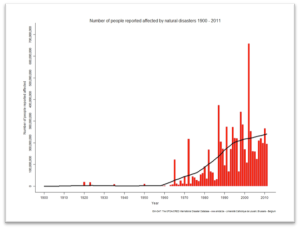Many of us in the development sector are actively thinking about the post-2015 context, and what the post-MDG agenda should look like. Stimulated by these reflections, and by related discussions at the recent Asia-Europe People’s Forum, I’ve been thinking about two mega trends that, if actually occurring, should fundamentally influence our post-MDG agenda.
Where do people living in poverty actually live?
Research from the Institute of Development Studies at the University of Sussex has found that 75% of people living in poverty actually live in middle-income countries. While some have questioned conclusions in the IDS paper, and the trend might not be permanent, it seems clear that the vast majority of people living in poverty live in countries with substantial economic resources.
This graph was included in a recent blog in The Economist, making the point that middle income countries can afford to establish social protection systems.
As can be seen in the figure, China has now reached the level of average wealth that enabled the establishment of Britain’s National Health service in 1948, and the American Social Security program, in 1935. Perhaps it’s not a coincidence that we are now seeing the rapid establishment of social protection systems in China.
Risks and Protection
The second trend I’ve been thinking about is, perhaps, more obvious – since the Boxing Day Tsunami, Hurricane Katrina, Cyclone Bopha, and Hurricane Sandy, we have seen the increase in weather-related events, and the parallel impact on people, the natural world, and built environments. This figure from the OFDA/CRED International Disaster Database shows how things are moving:
With human-induced climate change contributing to this trend, and carbon emissions on the rise, it’s fair to expect the numbers of people affected by natural disasters to continue to rise.
What does this mean?
If these two mega trends are real, I think they challenge us to rethink the way we should approach framing the post-2015 agenda. And the conclusion that I’m reaching, which was echoed at the Vientiane AEPF meeting, is that rather than focusing exclusively on projects that seek to reach certain defined populations, it’s time to pay much more attention to social protection.
Why? For two reasons: firstly, because the vast majority of people living in poverty are in countries that can reasonably be expected to support those projects. With support from outside? Sure. But as Chan Solin, Ricardo Gomez and I argue in a recent paper presented at the ANU / ACFID Conference on Participation (see the earlier post, below), this support should help governments fulfill their human rights obligations while also helping stimulate collective action on the part of populations being excluded from claiming their rights.
The way forward now, to continue to increase levels of human well-being, might be to help middle-income countries with large populations living in poverty to establish social protection systems – welfare for people at risk, unemployment, disability benefits, etc. Systems which represent a fundamental, though partial, solution to the inequities caused by the globalized capitalist system, rather than band-aids for some particular groups.
Of course, there will be a place for targeted projects. But do these mega trends change our thinking?
Food for thought.


